Eureka Grand Manan Tour Handleiding
Bekijk gratis de handleiding van Eureka Grand Manan Tour (4 pagina’s), behorend tot de categorie Tent. Deze gids werd als nuttig beoordeeld door 97 mensen en kreeg gemiddeld 4.4 sterren uit 49 reviews. Heb je een vraag over Eureka Grand Manan Tour of wil je andere gebruikers van dit product iets vragen? Stel een vraag
Pagina 1/4

ASSEMBLY INSTRUCTIONS
FOR THE GRAND MANAN
TOUR TENT
Component List: 1 Tent, 2 Tent Poles, 1 Screen Hoop, 1 Carry
Bag, 1 Pole Bag, 1 Stake Bag w/ Stakes and Guys, 1 Rain Fly
• Once the tent is securely staked, spread the rain fly
out, right side up. Start at one end and drag the fly up
and over the top of the te . It only fits one way. Align nt
the front door of the fly to the front entrance of the
screen room. See fig.7.
• Reach under the fly and wrap
the Velcro® straps through
the openings in the sleeves
and around the poles to
secure the fly to the tent
frame. See fig. 8.
• Also attach the wide Velcro®
straps to the patches on the
sleeves at each corner elbow.
See fig. 9
• Locate the long adjustable web/buckle
assemblies on the underside at each
corner of the fly. Attach these buckles to
their mates on the corner stake-out webs
and adjust to proper tension. See fig. 10.
• There are also, web/ring assemblies on the
bottom at each corner of the fly. Pull
these out and away from the tent and use
skewers to stake down. Adjust as
necessary. See fig.11.
• Grasp the web/rings on the door, pull
these out and away from the te . Stake nt
down and adjust the tension. Repeat at
the rear of the tent with the vestibule. See
fig.12
NOTE:
In strong winds, tie extra cords ( included ) to
.
NOTE: T r fam t t whis is a la ge ily s yle ent and e mend that ourecom y
ha e o eople for setuv tw p p.
Do not drop tent bag or pole bag on its
end. Do not bounce tent bag on its end to get the tent out. These
actions may cut the shock cord and/or damage the pole ends.
Rev B 4.09
Raise the tent:
• Unr oll and un old thf e tent and it on th lay e ground I it’s y. f wind , stake
do ront corner into d. wn one f win
• Lay the poles side by side and divide a ording to length. 2 long [11 cc
section] for the tent and 1 short [9 section] for the screen hoop.
• Assemble the shock corded
poles as you work. Try to
keep the pole sections from
snapping together, as this
can damage the ends. Make
certain each plain end has
been properly seated into its
metal ferrule. Slide one long
pole through each tent
sleeve. The poles run from corner to corner, cross at the center
through the sleeves. The ay pole fits to ay web. See fig 1 & 2gr gr
fig.4
fig.7
fig.10
fig.13
fig.11
fig.12
fig.14
fig.9fig.8
fig.5
fig.6
fig.2
fig.1
Stake it down:
• The tent is now freestanding. Place it in the desired location and use
the yellow stakes to stake it down through the corner web loops.
Stake diagonally opposite corners while applying tension to square
the tent and smooth any floor wrinkles.
Pull out the web loops from the screen room, use the skewers and
stake them down. It works best to do this before you add the fly.
See fig.6.
• Insert the post end of a pole into
the web grommet.
• At the opposite end, with the pole
in one hand and the web in the
other, feed the pole up, bending it
evenly along its length to create an
a . Make sure the ferrules do not rc
get caught on the sleeves. Place the
post end into this grommet to
maintain tension. Repeat with the
other tent pole. See fig. 3.
• Assemble and slide the screen room hoop over the tent
poles and through the front sleeve. Fit the post into the
outside grommet on same front webs as the tent poles.
See fig. 4.
• Attach all the pole clips to the hoop. See fig. 5.
fig.3
Feature:
The Grand Manan provides exceptional air flow.
Detach the web rings from the stakes. Roll up
the fly sides for 4-way ventilation. Secure in
place with the attached loops and toggles.
See fig. 14.
Take down:
Pull up stakes and open doors. Remove the
fly. Push poles out of the sleeves. Collapse all
poles and stow in the pole bag. Fold the
tent/fly. Roll up both along with the pole bag
towards a door. Stow all in the main bag.
YOUR TENT IS READY!

Good:
4 stakes /4 lines Best:
4 stakes /8 lines
REV E. JAN.10
SEAM SEALING:
We recommend use of a sealer such as Kenyon Seam Sealer 3 or McNett Outdoor
SeamGrip
®
.
• Work in a fully ventilated area.
• Set the tent up or lay the tent out flat. Taut seams allow for even application and
penetration of the sealer.
• Decide which seams need to be sealed. For example, seams that will be exposed
to rain, runoff, or ground level water are a must for sealing, while seams on
uncoated nylon or mesh panels don’t need treatment. There is no need to seal
the seams in the roof or the factory taped seams. We recommend sealing both
floor and fly seams and reinforcements.
• Apply sealant to the inside and outside of all exposed seams. Several thin layers
will work better than one thick layer. Read and follow manufacture's instructions.
STAKING:
All tents need to be staked down to keep them from blowing away. Securing the
tent by placing heavy objects inside is just not adequate.
• Once the tent body is erected, stake it out before the fly is put on. This enables you
to square the tent up to ensure that the fly goes on properly and that the seams
align with the frame. Pull the base of the tent taut between each web stake out
loop or ring & pin. Make sure that all corners are square. It is important that you
don’t stake the tent out too tightly. You will know it’s too tight, if the door zippers
can not be easily operated. Drive stakes through the web loops, or with ring & pin,
drive the stake just outside the ring so that the “J” hook catches it. Tie a piece of
cord or web into a loop through the ring to be used as a large stake loop if
needed.
• h e t y , dr e e fly r e fr , h s t Wit th ten properl staked ap th ove th ame attac it ten
connection points and stake down any pull outs.
• Do not attempt to remove the stakes by pulling on the tent becket loop, as this
could cause the fabric to tear. The best way is to pry on the stake itself.
Staking in special conditions:
• Sand. Use long, broad stakes with plenty of surface area in loose soil.
• . rd, R , or F n Ha ocky roze Soil l s kes w k best. e s l s kes Stee ta or Stor tee ta
separately. Their sharp edges can cut fabric and leave rust stains, which might
damage your tent.
• Snow. Use “dead man” anchors. Tie tent to buried objects (branches, tent bags, or
stuff sacks filled with snow; or tie tents to snow shoes, skis, or ski poles, which are
stuck in the snow.
GUY LINES:
Do not depend upon staking alone to keep your tent secure during high winds. Most
tent models have built-in loops or rings at optimal guy out locations. It’s important
to put in the extra time guying out your tent. Correctly done, it can save your tent
during exceptional weather.
• Make sure that the top fly is securely attached to the tent frame. Ties, hook and
loop, or dog-bones and elastic loops are sewn to the underside of the fly for this
purpose.
• Attach parachute cord to the loops/rings and stake them in the ground three or
four feet from the edge of the tent. If staked too close to the tent, wind can cause
an upward pull that could dislodge the stakes.
• If your tent does not have loops or rings for guy outs, attach guy lines 1/3 to
1/2 of the way up the framework on the main sidewalls. This enables the
guy line to support the lower section of the pole, while the upper pole can
flex and deflect wind gusts. It is best to run two cords at an angle from the
side of the guy out. This prevents all movement, except toward the anchor.
The guy lines will work together through opposition. See illust rations below:
CONDENSAT N & VENTING:IO
Through perspiration and breathing, an adult gives off about a pint of water
overnight. If it cannot escape, the water vapor condenses to liquid. Most
often, water found in the tent is a result of this condensation rather than
from the tent leaking. Condensation often forms where the sleeping bag
touches the side of the tent, under the sleeping pad, or on coated surfaces
such as the door flaps. A tent’s double wall construction allows the vapor to
escape through the roof to the outside, keeping the inside of the tent dry.
Leave the windows partially open at night to provide cross ventilation and
further reduce condensation. Cross ventilation becomes more important in
very humid or extremely cold conditions when the permeable roof is less
effective. The features that enhance ventilation are windows, short-sheeted
flys (bottom venting), roof vents, and High/Low venting doors. These are
specific to each tent model.
Given the importance of proper ventilation, We use High/Low venting in most
of our tents. This allows cooler air in through the low vents and warmer,
mo ou hrou th hi gh/ist air up and t t gh e gh nts. ve Hi Low v t g is en in
accomplished within the inner tent via roof vents, doors and windows. It is
important to vent the vestibule. Unvented, it can inhibit airflow into the tent.
Our tent vestibules profit from the ability to “short sheet” by means of
zippers & toggles and staked vestibule pull outs create a bellowing effect.
Most of our tents are equipped with a High/Low venting door. This design
all ea ai te ttows incr sed rflow into the nt f m the ro bo om. Open the low
vent/window to admit cool air, allowing the warmer air out through the
high roof vents. When rain and wind prevent the low vent from being
opened, the high door vent can still be used. Fly overhangs or vestibules
protect it.
ULTRAVIOLET LIGHT:
Ultraviolet light damage to tent fabric is caused by excessive exposure to
sunlig . le our rics are UV r i a , any nt tic c is ht Whi fab es st nt sy he fabri
susceptible to UV degradation. UV damage will cause nylon and polyester
to become brittle and tear easily. We recommend that you use the rain fly
even on clear days. It acts as a sunscreen to the tent. A rain fly is both easier
and less expensive to replace if damaged. UV damage can be minimized by
erecting tents on shaded sites with low exposure to direct sunlight.
GENERAL POLE CARE:
• Never let tent poles snap together as this can damage the pole end.
• Do not drop tent or pole bags on their ends and do not bounce a tent bag
on its end to get the tent out. These actions may cut the shock cord and
damage the pole ends.
• The aluminum frame may bend slightly and take a “set” through usage; this
normally does not affect the performance of the frame.
GENERAL TENT CARE:
• Sweep the tent floor daily to prevent damage from stones.
• Try not to wear shoes inside your tent.
• Use a ground cloth whenever possible.
• Do not keep food inside a tent. Hungry critters will chew through tent fabric in
search of food.
STORAGE:
• Make sure the tent is completely dry, then store loosely rolled, in a dry, cool
place. To prevent dust from collecting on the tent, cover it with a cloth. This
allows the nylon/polyester fabric to breathe.
• Ideally, the tent poles should be stored in their fully assembled state. This
reduces the tension on the shock cord, prolonging its life.
• The tent bag should be used only as a carry sack and not for storage.
COLOR TRAN ER:SF
• Do to the nature of tent fabrics, color can transfer from darker to lighter
fabrics when the two fabrics are in contact over time when wet, damp or
exposed to the combination of moisture and high heat. This does not effect
the tent's performance. To prevent / minimize color transfer, always make
sure your tent is completely dry prior to packing and storage.
CLEA NG:NI
• Clean the tent by setting it up and wiping it down with a mild soap (liquid
han soap an luk wa olu ion Rins tho ou hld ) d ewarm ter s t . e r g y and dry
completely. Never use detergent, washing machines or dryers because they
can damage the tent’s protective coating and seams. After cleaning, be sure
the tent is completely dry, especially the heavier, double-stitched areas such
as the seams, before storing or mold / mildew are likely to grow.
• Clean the tent poles with a cloth and lubricate them with silicone spray. This is
especially necessary after ocean side camping to remove salt spray so the
poles don’t corrode or stay gritty.
• Clean the zippers with a quick dip in water and then dry them off. This is
especially important if you’ve been camping in a location with sand/dirt. If
you don’t clean the zippers, the sliders will wear out and eventually the teeth
will become inoperable.
ALTERAT NS OR DI CATI S:IO MO FI ON
DO NOT misuse, modify or alter this product in any way from its condition at
the time of sale. Alteration, modification or any use of this product contrary
to the accompanying written instructions shall void the warranty. Moreover,
any misuse, alteration or modification of the product shall absolve Johnson
Outdoors Gear LLC of any liability for property damages or injuries sustained
as a result of such misuse, modification or alteration.
L ITED WA ANTY:IM RR
Wha edt Is Cover : Johnso doorn Out s r LLC Gea
wa igirrants to the or nal
purchaser that its products are free from defects in material and workmanship,
for the life of the product, except as qualified below. The life of the product is
determined from the date of purchase until such time as the product is no longer
serviceable due to normal wear and tear.
What Is Not C er ov ed:
Johnson Outdoors Gear LLC
a t sh ll no be responsib for th le e
natural a o of ri t oc t bre kd wn mate als tha curs inevi ably wi ex (e ., ra th tended use .g Ult
Viol (UV)et l t aigh dam ge on tents exhaust , ed de c c zippers), or fe ts aused by cciden a t,
a e teratbus , al ion, an ma attai l ck, a ge, e c . storm d ma misus or improper are
T RE ARE NO OT R EXPR S WARRANT S YOND THE TE S OF THIS HE HE ES IE BE RM
L ITED WARRANTY. IN NO EVENT SHALL JOHNSON OUTDOORS GEAR LLC BE IM
LIABLE FOR INCIDENTAL OR CONSEQ NTIAL DAMAGES. UE
Some provinces do not allow the exclusion or limitation of incidental or consequential
damages, so the above limitation or exclusion may not apply to you.
What Johnson Outdoors Gear LLC Will Do: If after inspection we find that a
product failed due to a manufacturing or material defect, we will repair or
replace the product, at our option, without charge.
How to Obtain Warranty Service: Return the product, freight prepaid, to the
Dealer from whom it was purchased; or, contact our Customer Satisfaction
Departmen re ur authoriza ion to fre Colt for t n t : ll e . 1 800 263 6390 lect
shipments or shipments without return authorization cannot be accepted. The
product registration card packaged with our product need not be returned for
the warranty to be effective and for you to receive warranty service.
Repairs: If your
Johnson Outdoors Gear LLC
product needs service or repair
due to normal wear and tear, animal attack, accident or some other reason
that is not covered under the warranty we will provide the necessary service
for a reasonable charge, plus shipping and handling. We require that products
accepted for any repair be properly cleaned according to our recommended
care instructions. Please send your product or component that requires repair
( ., nt fl , e ep d, g with a descript n of at n ds e.g te y) postag pr ai alon io wh ee
attention. For service and repairs, please contact our Customer Satisfaction
Department: toll free 1 800 263 6390
Our experience building quality
outdoor equipment goes back over 100
years! Today, we manufacture sleeping
bags, screen houses, day-use
shelters camping tentsand . We also
design and manufacture tents for the
United States Military and for the
rental industry .
See eur comekatents.
From baseplate and digital
compasses to electronic
instruments, our sister brands, Silva
and Tech4o, put outdoor technology at
your fingertips.
See tech4o.com and silvausa.com
Our brands are part of the Johnson
Outdoors family of products. Visit all
the brands at johnsonoutdoors.com
We support the "Leave No Trace"
Seven Principles:
1. AN AHEAD AND PREPAREPL
2. TRAVEL & CAMP ON DURABLE RFACESSU
3. D POSE OF WASTE PROPIS ERLY
4. LEAVE WHAT YOU DFIN
5. E CAMP E PACTSMINIMIZ FIR IM
6. ECT WILDL ERESP IF
7 . BE COURTEOUS OF OTHER VISITORS
JOHNSON OUTDOORS GEAR LLC
WAR NG:NI
K P ALL AME AND HEAT SOURCES AWAY FROM THIS TENT FA IEE FL BR C.
• This tent meets the flammability requirements of CPAI-84. The fabric may
burn if left in continuous contact with any flame source. The application of
any foreign substance to the tent fabric may render the flame-resistant
properties ineffective.
• Do NOT operate any device which burns fuel inside your tent. Combustion
consumes oxygen and can produce dangerous levels of carbon monoxide,
which could lead to serious injury or death.

Rev B 4.09
:
fig.4
fig.7
fig.10
fig.13
fig.11
fig.12
fig.14
fig.9fig.8
fig.5
fig.6
fig.2
fig.1
fig.3
Haubanage de la tente :
• La tente se tient debout toute seule maintenant. Posez-la à l’emplacement voulu
et stabilisez-la aux coins en enfonçant les piquets jaunes au travers des boucles
des sangles de fixation. Il faut haubaner les coins opposés pour assurer une sta-
bilisation diagonale, tout en appliquant un peu de tension pour former un carré et
éliminer les plis dans la sous-toile.
• Tirez sur les boucles de la toile de l’aire en moustiquaire, puis utilisez des
broches pour les fixer au sol. Il vaut mieux faire cette étape de haubanage avant
d’ajouter l’auvent. Voir la figure 6.
Fixation de l’auvent à la tente :
• Une fois la tente bien haubanée avec les piquets, étalez l’auvent
anti-pluie, le bon côté vers le haut. En commençant par un bout, tirez
l’auvent par-dessus la partie supérieure de la tente. Il n’y a qu’un
sens possible. Alignez la porte avant de l’auvent sur l’entrée avant de
l’aire en moustiquaire. Voir la figure 7.
INSTRUCTIONS DE
MONTAGE
POUR LA TENTE
GRAND MANAN TOUR
Liste de composants : 1 tente, 2 mâts de tente, 1 arceau, 1 sac de transport, 1
sac pour mâts, 1 sac pour piquets, avec piquets et haubans, 1 auvent anti-pluie
NOTA : Étant donné qu’il s’agit d’une tente familiale, nous recommandons que deux per-
sonnes s’occupent de l’installation. Il ne faut pas laisser tomber le sac de tente ou le sac
de mâts sur une extrémité; il ne faut pas non plus secouer le sac de transport par l’ex-
trémité pour faire sortir la tente. De telles actions risquent de couper le cordon solidarisé
ou d’endommager les bouts des mâts
Érection de la tente :
• Déroulez et dépliez la tente puis posez-la par terre. S’il est venteux, fixez l’un des
coins avant de la tente face au vent.
• Posez les mâts côte à côte et divisez-les selon la longueur : 2 mâts longs [à 11 sec-
tions] pour la tente et 1 mât court [à
9 sections] pour l’arceau de l’auvent.
• Assemblez les mâts solidarisés au
fur et à mesure. Évitez que les sec-
tions de mâts ne s’entrechoquent, ce
qui risquerait d’endommager les
bouts. Assurez-vous que chaque
bout de mât dégarni s’insère cor-
rectement dans la virole métallique.
Glissez chaque mât long dans le
manchon de la tente prévu à cet
effet. Les mâts relient les coins opposés et se croisent au centre. Le mât de couleur
gris va avec la toile grise. Voir les figures 1 et 2.
• Insérez l’extrémité fermée d’un mât dans
l’oeillet de la sangle de toile.
• À l’extrémité opposée, le mât dans une
main et la toile dans l’autre, poussez le
mât vers le haut graduellement, en le cour-
bant uniformément sur toute sa longueur
afin de créer un arc. Assurez-vous que les
embouts ne s’accrochent pas aux man-
chons. Insérez l’extrémité du mât dans
l’oeillet correspondant afin de maintenir la
tension. Répétez avec l’autre mât de la
tente. Voir la figure 3.
• Montez l’arceau pour l’aire en moustiquaire et passez-le par-dessus les mâts et au
travers du manchon avant. Insérez le mât dans l’oeillet extérieur sur les sangles
de fixation où les mâts sont installés. Voir la figure 4.
• Fixez tous les clips de mât à l’arceau. Voir la figure 5.
POUR LA VIE EN PLEIN AIR
Fixation de l’auvent à l’arma-
ture :
• Passez le bras sous l’auvent pour
envelopper les sangles en Velcro®
au travers des ouvertures dans les
manchons et autour des mâts, afin
de bien fixer l’auvent à l’armature de
la tente. Voir la figure 8.
• Fixez aussi les attaches larges en
Velco® aux pièces de renforcement
sur les manchons à l’endroit des
coudes des coins. Voir la figure 9.
• Repérez les longues sangles de
toile à boucle réglables sur le dessous, à chaque
coin de l’auvent. Fixez chacune de ces boucles à
la boucle correspondante sur la sangle de coin où
un piquet sera installé, puis réglez la tension. Voir
la figure 10.
• Ces sangles de toile à anneau se trouvent égale-
ment au bas de l’auvent à chaque coin. Tirez sur
ces sangles pour les éloigner de la structure de la
tente puis utilisez les broches pour les haubaner
au sol. Réglez la tension au besoin. Voir la figure
11.
• Empoignez les anneaux des sangles de la porte et
tirez pour les éloigner de la tente. Haubanez cha-
cune avec un piquet et ajustez la tension. Répétez
pour le vestibule à l’arrière de la tente. Voir la fig-
ure 12.
NOTA : S’il vente beaucoup, attachez des cordons
supplémentaires (compris) aux anneaux-tempête
sur l’auvent et fixez-les au sol à l’aide de piquets.
Ajustez le curseur pour que les cordons restent bien
tendus. Voir la figure 13.
Caractéristique spéciale :
La conception de la tente Grand Manan assure une
circulation d’air exceptionnelle. Détachez des pi-
quets les anneaux des sangles. Hissez les côtés de
l’auvent pour permettre une ventilation 4 voies puis
fixez-les en place à l’aide des boucles et boutons en
bâtonnet intégrés. Voir la figure 14.
Démontage :
Arrachez les piquets et ouvrez les portes. Enlevez
l’auvent. Retirez les mâts des manchons en pous-
sant sur eux. Télescopez les mâts et rangez-les
dans le sac pour mâts. Pliez la tente et l’auvent; en-
roulez-les ensemble avec le sac de mâts dans la di-
rection de l’une des portes. Rangez le tout dans le
grand sac de transport.
VOTRE TENTE EST PRÊTE!
Product specificaties
| Merk: | Eureka |
| Categorie: | Tent |
| Model: | Grand Manan Tour |
Heb je hulp nodig?
Als je hulp nodig hebt met Eureka Grand Manan Tour stel dan hieronder een vraag en andere gebruikers zullen je antwoorden
Handleiding Tent Eureka

2 Juni 2023

15 Mei 2023

13 Mei 2023

12 Mei 2023

10 Mei 2023

7 Mei 2023

6 Mei 2023

4 Mei 2023

3 Mei 2023

2 Mei 2023
Handleiding Tent
- Wechsel
- High Peak
- Robens
- De Waard
- Inaca
- Woods
- Skandika
- Bestway
- Goldcamp
- MSR
- Brunner
- Gerjak
- Fiamma
- Raclet
- Carl Denig
Nieuwste handleidingen voor Tent
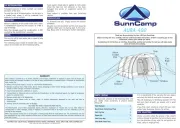
1 September 2025
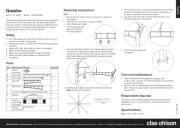
15 Juli 2025
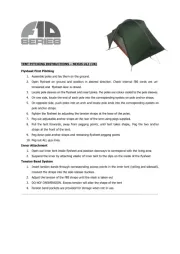
14 Juli 2025
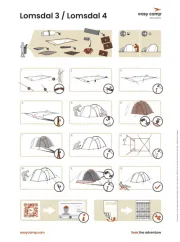
14 Juli 2025
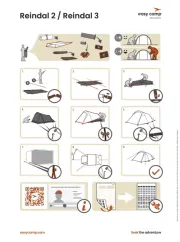
14 Juli 2025
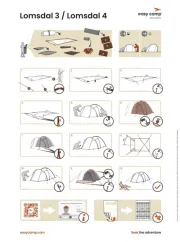
14 Juli 2025

6 Juli 2025
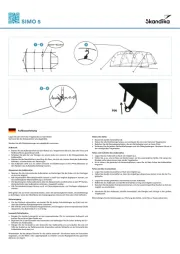
5 Juli 2025
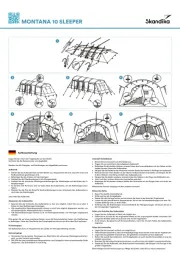
2 Juli 2025
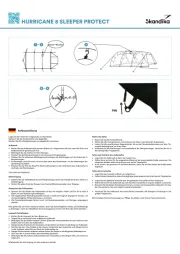
2 Juli 2025